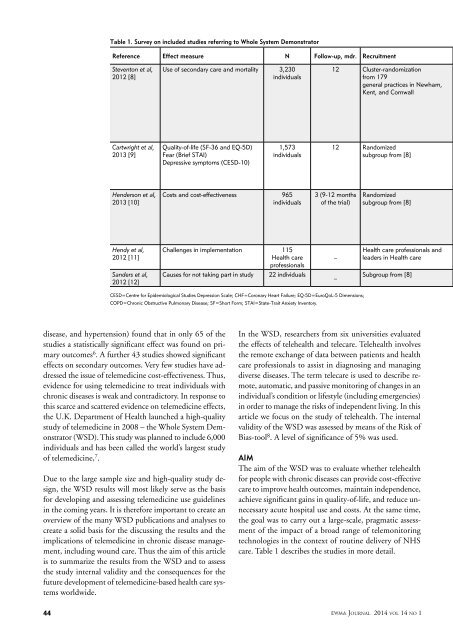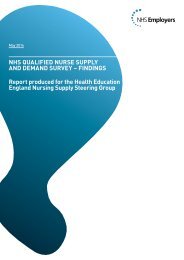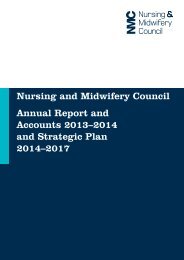Journal_1_2014_final_WEB
Journal_1_2014_final_WEB
Journal_1_2014_final_WEB
Create successful ePaper yourself
Turn your PDF publications into a flip-book with our unique Google optimized e-Paper software.
Table 1. Survey on included studies referring to Whole System Demonstrator<br />
Reference Effect measure N Follow-up, mdr. Recruitment<br />
Steventon et al,<br />
2012 [8]<br />
Use of secondary care and mortality 3,230<br />
individuals<br />
12 Cluster-randomization<br />
from 179<br />
general practices in Newham,<br />
Kent, and Cornwall<br />
Cartwright et al,<br />
2013 [9]<br />
Quality-of-life (SF-36 and EQ-5D)<br />
Fear (Brief STAI)<br />
Depressive symptoms (CESD-10)<br />
1,573<br />
individuals<br />
12 Randomized<br />
subgroup from [8]<br />
Henderson et al,<br />
2013 [10]<br />
Costs and cost-effectiveness 965<br />
individuals<br />
3 (9-12 months<br />
of the trial)<br />
Randomized<br />
subgroup from [8]<br />
Hendy et al,<br />
2012 [11]<br />
Challenges in implementation 115<br />
Health care<br />
professionals<br />
Causes for not taking part in study 22 individuals<br />
–<br />
Health care professionals and<br />
leaders in Health care<br />
Sanders et al,<br />
2012 [12]<br />
–<br />
Subgroup from [8]<br />
CESD=Centre for Epidemiological Studies Depression Scale; CHF=Coronary Heart Failure; EQ-5D=EuroQoL-5 Dimensions;<br />
COPD=Chronic Obstructive Pulmonary Disease; SF=Short Form; STAI=State-Trait Anxiety Inventory.<br />
disease, and hypertension) found that in only 65 of the<br />
studies a statistically significant effect was found on primary<br />
outcomes 6 . A further 43 studies showed significant<br />
effects on secondary outcomes. Very few studies have addressed<br />
the issue of telemedicine cost-effectiveness. Thus,<br />
evidence for using telemedicine to treat individuals with<br />
chronic diseases is weak and contradictory. In response to<br />
this scarce and scattered evidence on telemedicine effects,<br />
the U.K. Department of Health launched a high-quality<br />
study of telemedicine in 2008 – the Whole System Demonstrator<br />
(WSD). This study was planned to include 6,000<br />
individuals and has been called the world’s largest study<br />
of telemedicine, 7 .<br />
Due to the large sample size and high-quality study design,<br />
the WSD results will most likely serve as the basis<br />
for developing and assessing telemedicine use guidelines<br />
in the coming years. It is therefore important to create an<br />
overview of the many WSD publications and analyses to<br />
create a solid basis for the discussing the results and the<br />
implications of telemedicine in chronic disease management,<br />
including wound care. Thus the aim of this article<br />
is to summarize the results from the WSD and to assess<br />
the study internal validity and the consequences for the<br />
future development of telemedicine-based health care systems<br />
worldwide.<br />
In the WSD, researchers from six universities evaluated<br />
the effects of telehealth and telecare. Telehealth involves<br />
the remote exchange of data between patients and health<br />
care professionals to assist in diagnosing and managing<br />
diverse diseases. The term telecare is used to describe remote,<br />
automatic, and passive monitoring of changes in an<br />
individual’s condition or lifestyle (including emergencies)<br />
in order to manage the risks of independent living. In this<br />
article we focus on the study of telehealth. The internal<br />
validity of the WSD was assessed by means of the Risk of<br />
Bias-tool 8 . A level of significance of 5% was used.<br />
Aim<br />
The aim of the WSD was to evaluate whether telehealth<br />
for people with chronic diseases can provide cost-effective<br />
care to improve health outcomes, maintain independence,<br />
achieve significant gains in quality-of-life, and reduce unnecessary<br />
acute hospital use and costs. At the same time,<br />
the goal was to carry out a large-scale, pragmatic assessment<br />
of the impact of a broad range of telemonitoring<br />
technologies in the context of routine delivery of NHS<br />
care. Table 1 describes the studies in more detail.<br />
44<br />
EWMA <strong>Journal</strong> <strong>2014</strong> vol 14 no 1




